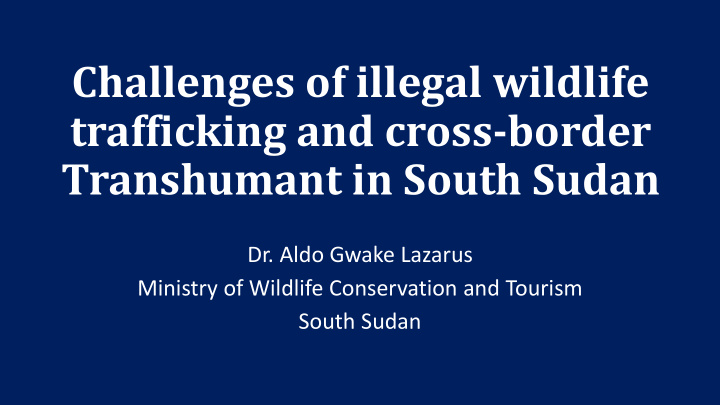



Challenges of illegal wildlife trafficking and cross-border Transhumant in South Sudan Dr. Aldo Gwake Lazarus Ministry of Wildlife Conservation and Tourism South Sudan
Presentation: • Introduction • The problems • Challenges • Current efforts • Way forward
• 630 km 2 is rich in biodiversity, represented in 19 Protected • borders with six countries • long borders with CAR and DRC in western regions of the country
• There are 8 out of the 19 Protected Areas in South Sudan, share borders with CAR, DRC and Sudan. • These PAs share common challenges with PAs across the international borders. • They include the following:
− Boro Game Reserve – Bordering CAR − Numatina Game Reserve – near CAR − The Southern National Park – close to Numatina − Bangangai Game Reserve – bordering DRC
− Mbarizonga Game Reserve – bordering DRC − Bire Kpatua Game Reserve – Bordering DRC − Lantoto National – across the border from Garamba in the DRC − Ashana and Chelkuo – near Sudan borders
The Problem at Hand • Movements of poachers and trafficking within the region is a reality, even though data is insufficient. • It has been there for long time over decades
Poaching and trafficking: Armed group around Tombura State.
Movements of armed poachers: • They cross western and north-western borders into South Sudan PAs from CAR and Sudan. • They transverse through Boro and Numatina; Southern Park and Lantoto and into Garamba. • They are notorious and dangerous poachers.
• Movements of pastoralists (Mbororo) has been there for decades. • Latest seen in Bangagai Reserve in August 2018; and Southern Park in Jan 2019. • They cross borders for cattle grazing in South Sudan.
• They Pose potentials of: − Poaching − Insecurity − Transmission of zoonotic diseases
• Armed conflicts in the country/neighbours impact negatively on practical conservation work. • Proliferation of small arms in hands of local people (war effect) used in poaching.
Proliferation of small arms in hands of local people (war effect) used in poaching
Little research, fieldwork and data available
• The borders are large spanning over hundreds of kilometres making it difficult for controlling from side one country single-handedly. • Practical difficulties such as lack of communications and logistics support hinders actions when armed groups are reported.
• Insufficient support for studies and documentations on site. • Problems of coordination, difficulty in communication and information sharing between neighbouring countries. • Recent trafficking attempts (ivory) by international syndicates through the country have been foiled.
Current efforts • Despite all challenges conservation work never stopped: • Government maintained core ranger force operations in Protected Areas • WCS is supporting Lantoto Park; and FFI supporting Bire-Kpatua reserve
Training, fieldwork is on-going despite limited resources: pictures from Lantoto Park
Arrests and seizures:
Poachers of small mammals not spared
Arrested suspects are charged and prosecuted – Lantoto Park
After prosecution exhibits are put beyond economic use to ensure zero chance for smuggling
The Way Forward • Capacity and capabilities of wildlife protection rangers to be supported to meet the challenges. • Regional coordination, international cooperation is necessary as no country can do it single-handedly. • South Sudan (emerging country) should be assisted in addressing these challenges.
• The recently signed peace agreement paves the way for practical solutions in the affected protected areas. • South Sudan is a member of cross-border wildlife protection initiatives in the IGAD region (HAWEN). Similar arrangements with the Congo Basin Region can be of help, for the challenges being addressed.
• Support to the affected protected areas for management effectiveness and enforcement: − field equipment and materials − mobility − communications • An internationally supported Trans-boundary conservation programs between neighbouring protected areas would rescue the situation.
Thanks
Recommend
More recommend